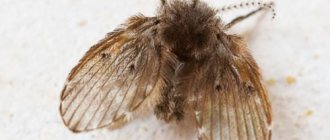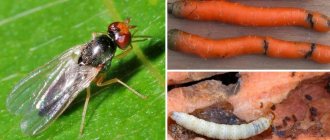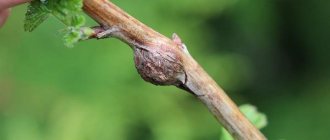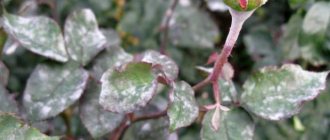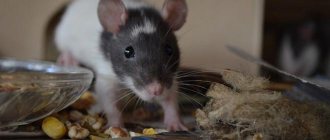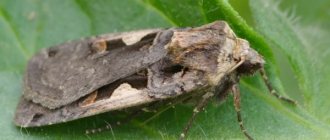Description of the parasite
- Species characteristics
The scale insect is a small sucking insect from the family Hemiptera, the superfamily of scale insects. There are more than 2,400 species, and almost all of them are pests of fruit and berry and ornamental crops, as well as forest plants. Distribution area: steppe strip, Central Asia and subtropics. The wintering phase and reproduction during the growing season depend on the climate of the habitat and the species.
- Appearance
Females are characterized by neoteny (they reach sexual maturity in the early stages of development). Therefore, they are deprived of limbs, eyes, and antennae. They resemble larvae. There is no clear division into head, abdomen and chest. The body is covered with a dense shield (hence the name), which is easily separated from the insect. The shape is different: oval, round, elongated, pear-shaped. The average length is 1.5 mm (there are also larger specimens). Males have wings, normally developed legs and antennae, and a reduced mouthparts. Length - 1-1.2 mm (smaller than the female). Life expectancy is 1-3 days. Some species have no males at all. The eggs are small, transparent, almost invisible to the human eye.
- Development
Males go through 5 stages of development, females - only 3. At the first, the larvae are no different from each other and begin to disperse - independently or passively, with the help of the wind or on other flying insects (this phenomenon is called phoresy). Some species lay eggs that survive the winter well. There are also viviparous ones.
- Parasitism on plants
During resettlement, scale insects end up on garden plants. With their proboscis they stick to it (no matter what part it is - trunk, shoots, leaves, flowers, roots) and feed on cell sap. After propagation, cover it with a continuous layer.
What is the danger to the plant?
Scale insects suck cell sap from plants, which negatively affects their growth and development:
- in places of sucking, cells hypertrophy, healthy tissues become distorted, and various growths form;
- this disrupts the decorative appearance of plants and significantly reduces the yield of fruit and berry crops;
- sugary secretions of insects are a fertile environment for the development of saprophytic fungi that infect the plant with honeydew or blackworm;
- sap flow is disrupted, which leads to necrosis of the phloem, then drying out of individual parts (branches, leaves) and, finally, to the death of the entire plant.
The scale insect does not pose a danger to humans. If only it causes irritation and nervousness with its huge populations on your favorite plants. Fruits from trees that are under their sight can be eaten after thorough rinsing under hot water. They often lose their taste and are poorly stored due to disturbances in sap flow.
Signs of infection
- The appearance of honeydew - a sticky liquid that forms in large quantities, so that it can even drain from the branches;
- curvature of shoots;
- slow growth;
- the presence of small brown or yellowish round scales (plaques, growths) on different parts (on leaves, trunk, branches);
- the formation of yellow spots on the leaves, which grow and turn brown, and then form cracks and holes;
- yellowing, and then drying and falling of leaves;
- drying of entire branches;
- in the later stages, the entire plant is covered with insects.
To see scale insects in the early stages, you need to arm yourself with a magnifying glass. You should consider the points where branches connect with the trunk, petioles and the lower part of leaves - these are favorite places for insects. They look like spots.
Insect species
As already mentioned, in total there are about 2,400 species of thyroid glands in nature. Each has its own characteristics, which determine the harm they cause to plants. If you know their distinctive features, you can promptly detect them on your site and choose the right means for destruction.
Table
- Quarantine insects
As can be seen from the table, the mulberry and Californian scale insects are considered the most dangerous. They are practically omnivorous and are capable of destroying almost an entire garden plot in one invasion. Therefore, they are classified as quarantine insects. This means that in the regions where an outbreak of infection has been recorded, a system of quarantine measures is being organized: strict inspection of seed and planting materials, food products, plant and industrial raw materials, and their thorough inspection during export. In central Russia, the Californian scale insect is very rare. It usually causes damage to the Far East and the Kuril Islands.
- Targets
In the table they are indicated conditionally, otherwise no cells would be enough to accommodate all those crops on which one or another type of scale insect can live. For example, comma-shaped was already found on 150 species of plants (both ornamental and garden, as well as forest). Experts are confident that this list will gradually grow. Some species even attack those trees and shrubs that are protected by nature from all insects with toxic substances. These include, for example, noble laurel and white derain.
- How to distinguish from false scale insects?
There is also the so-called false scale insect (false scale insect), which is easy to distinguish from the usual one. She has a pea-shaped shield, not flat. It practically grows together with the insect, so plucking it from the plant is not so easy. But it is devoid of a wax coating, soft, and therefore susceptible to destruction under the influence of insecticides.
Habitat
The scale insect is distributed all over the world; many species came to us from other continents. Insects have many ways to expand their habitat. From remote regions and other countries, the pest comes along with plants brought by importers. It is not easy to detect it in small quantities, so when buying a flower in a store there is no guarantee that the pest will not enter the house.
One female is enough, which can produce offspring without an individual of the opposite sex.
Scale insects live on indoor flowers and in the garden. Plants wither and die due to pest invasion. You can bring insects home in the following ways:
- pick flowers from the field;
- buy an infected plant, from where scale insects will move to others;
- pests can migrate from neighbors through the balcony where flowers are displayed in the summer;
- rarely, but it happens that they are carried by the wind.
Interesting! Pests are able to move to new places along with other insects that can travel long distances.
Features of damage to different crops
Timely recognition of insect infestation and competent selection of methods to combat them also depends on which plant is affected:
- the olive or brown scale insect most often settles on the laurel, since its favorite delicacy is precisely the leaves, on the upper side of which it usually settles;
- on lemon there is a red orange scale, after which the fruits and leaves fall off, and the citrus fruits themselves dry out;
- on an apple tree - the apple scale insect, which is dangerous because it lays larvae directly under the bark of the tree, which suck all the juices out of the wood;
- on euonymus trees there is the euonymus scale insect, the males of which are white: when there are many of them, the bushes seem as if sprinkled with flour;
- on plum - mulberry, whose second name is white plum, infects almost all garden plants;
- on peach - common comma, very similar to apple comma;
- on cherries - purple (it also often infects plums and peaches) is dangerous because it can produce up to 4 generations in a year.
Since there are a huge number of varieties of scale insects, for each of them there is a plant that they will prefer to all others. Not counting the mulberry and Californian, which are omnivores.
How to get rid of scale insects on indoor plants?
Before you start fighting a pest, you should be very careful, it would be a good idea to use a magnifying glass.
Absolutely all parts of a potted flower are subject to inspection:
- trunk;
- stem;
- leaf sinus;
- leaf plate (top and bottom).
Note! If the reasons for concern are not unfounded, then the plant should be placed in “quarantine” and processing should begin. There are many methods and methods of processing and it is worth proceeding with a detailed consideration of them.
Control measures
The problem is that getting rid of scale insects is not as easy as it might seem at first glance. The insect is protected by a strong waxy shield, which not all insecticidal preparations can penetrate.
Chemicals
If the scale insect is detected at an early stage (there are not many insects on the plant yet), any insecticide will help get rid of it. The drugs should be used according to the instructions:
- wear a protective suit, mask (goggles), gloves;
- dilute in the required amount of water (prepare a solution);
- Stir thoroughly and pour into a spray bottle;
- in the evening or early in the morning, in calm and dry weather, spray on the infected plant, especially carefully treating those places where insects were found;
- Spraying should be carried out as many times as indicated in the instructions for the product.
If the population has already increased significantly, such light irrigation will no longer be enough to kill insects. You will have to practice much more labor-intensive methods of struggle. In particular, mechanical harvesting by hand (for ornamental low plants and indoor plants). Many will find it unacceptable due to the scrupulousness and large time costs. However, if you want to save the plant, you will have to do it. The action algorithm will be as follows:
- Prepare a solution of Aktara or Karbofos.
- Soak a cotton pad in it (suitable for small plants) or a toothbrush (it’s best to use it for treating shrubs and trees).
- Thoroughly wipe the areas where scale insects accumulate. The cotton pad should be changed as often as possible as it is used. Toothbrush - moisten again and again in the insecticide solution.
- If you are sure that you have removed all the individuals, spray the entire plant, as well as neighboring ones, with the same preparation.
- The next day, water them with Aktara solution.
- Repeating the entire algorithm in a week is more for prevention.
How many times should a plant infected with scale insects be watered with Aktara? It depends on the extent of the damage. After the first abundant watering, repeat it only a week later. If there are too many insects, then a third time will not hurt. If after the second they disappear, there is no need to use chemical control methods again.
Recommended drugs:
- ExtraFlor against scale insects and spider mites for vegetable and flower crops;
- Aktara is a broad-spectrum insecticide for the protection of currants and flower crops;
- Actellik - for vegetables, berries and ornamental crops;
- Bona Forte is a modern insecticide (treatment + prevention) against scale insects, whiteflies and mealybugs;
- Karbofos against pests on fruit, berry, flower crops and grapes;
- Inta-vir is a water-soluble tablet for pest control;
- Bankol is a wettable powder insecticide of contact-intestinal action for the control of Coleoptera.
It should be remembered that the treatment of fruit and berry crops with chemicals should be carried out before the ovaries form. Despite the promises of many manufacturers that their insecticides are absolutely safe for humans, additional precautions would not hurt.
Helpful advice. Before treating a plant with an insecticide, try spraying it on some local area (a separate branch) to see the reaction and not ruin the crop without having time to cure it.
Folk remedies
No folk remedy will get rid of scale insects 100%. Many of them have too gentle an effect, which is not capable of destroying the waxy shell that covers insects. However, there is one undeniable advantage of folk methods of struggle - they are completely safe for human health in most cases. You can try them in the early stages of infection.
- Soap-alcohol solution
Mix 15 g of liquid soap and 10 ml of denatured alcohol, dilute in 1 liter of warm water. If the plant is thin- or soft-leaved, the solution is applied with a brush directly to the insects. The remaining parts can simply be sprayed.
- Kerosene-soap mixture
Dilute 30 g of green or 50 g of grated laundry soap in 1 liter of water. Add 1 tbsp. l. kerosene.
- Soap-oil emulsion
Dissolve 100 g of grated laundry soap (or the same amount of washing powder) in 5 liters of warm water. Beat until foam forms. Add 150 ml machine oil. Spray the infected plant. Cover it with film for 12 hours. After this, irrigate thoroughly with cold water. Repeat three times with an interval of 1 week.
- Milk-water solution
Dilute 200 ml of milk in 1 liter of warm water, add half a bottle of 5% iodine. Use for spraying.
- Garlic infusion
Chop 5 garlic cloves, add 200 ml of warm water, leave covered for a day. Filter and use a brush (or toothbrush) to apply the solution to leaves and shoots covered with scale insects.
- Onion infusion
One small onion is chopped and filled with 1.5 cups of warm water. The rest is according to the previous recipe.
- Pepper infusion
Chop red capsicum (50 g), add 0.5 liters of water, boil for 15 minutes. Leave for a day. Filter. Can be stored for 3 months in a sealed dark bottle.
If the situation is severe, leaves and stems covered with insects can be cleaned with a toothbrush soaked in vodka, onion gruel, or kerosene.
Treatment with folk remedies can be done more often than with chemicals due to their safety.
Agricultural technology
In addition to the above, it is also necessary to use all possible agrotechnical control measures.
- If possible, provide the crop with maximum sunlight and heat - these conditions are detrimental to scale insects.
- If the scale insect is localized on certain shoots or leaves, it may make sense to remove them entirely and burn them outside the garden. The cut site must be healed with garden varnish.
- After treatment, the plant must be fed with seasonal fertilizers.
- Remove the old layer of mulch, dig up the tree trunk, cover it with new pine needles or ash and peat.
- Follow quarantine rules.
- Clear the trunks of dead bark, where entire colonies of insects may be located. Burn it.
- If an old tree of no economic value is infected, it should be removed from the garden.
You need to fight scale insects using any means at your disposal. Do not limit yourself to just spraying with Aktara or another insecticide. Irrigation and watering should be regular. Additional use of agrotechnical control measures will only increase the chances of getting rid of pest infestations.
Causes of appearance and damage caused
The danger of scale insects is indicated by the following fact:
In the event of a massive attack of this insect on open ground crops in the region, a quarantine may be declared, including a ban on the export of plants and their parts. Under favorable conditions, it easily spreads to neighboring plants.
Therefore, read where it can appear in your indoor plant kingdom and take protective measures.
In the vast majority of cases, scale insects come to houseplants from other green plants purchased from collectors or nurseries.
Less often, it moves from plants in the open ground to indoor flowers that have been taken outside. Or from branches, fruits and leaves of infected specimens.
In very rare cases, pest larvae can be carried through the air onto flowers standing on the balcony.
Information Scale insects are a prolific and dangerous pest. If the plant is left untreated for a long time, then she may fall in love with it completely, and it will only take her 3-4 years to destroy a large tree!
The scale insect is dangerous because it gnaws holes in the leaves and stems through which it sucks out the juices of the plant. It quickly becomes depleted, lacking nutrients, and slowly dies.
You can prevent the appearance of scale insects by following a few simple rules:
- carefully inspect all purchased indoor plants for pests;
- keep new specimens for a week on a separate windowsill before moving them to the rest of the collection;
- take good care of your green pets, as healthy plants have some natural immunity against pests;
- cut off dried and damaged leaves and branches;
- Rinse plants in the shower after moving them from the open air into the house.
Prevention
How to organize it correctly?
- Regularly inspect all plants in the garden for infections and insects.
- Avoid crowding of plantings: maintain sufficient distance between seedlings.
- Watering should be moderate. Do not allow water to stagnate in the tree trunk circle. Humidity is an ideal condition for the development of scale insects.
- Twice a year (spring and autumn) prune to improve crown ventilation.
- Twice a year (spring and autumn) treat the entire garden with an insecticide. If there is a threat of invasion in the summer, do it again, unscheduled.
- Control and discard planting material: purchase and plant only healthy seedlings on the site.
- Do not remove natural enemies of scale insects from the garden - seven-spotted ladybugs, bedbugs, ground beetles, syrphid flies and lacewings.
Scale insects are an insidious insect that is difficult to fight. At first, it is too inconspicuous to notice the infection in a timely manner. And in the final stages it is already too late. An invasion of a garden threatens the death of a variety of plants - flower and vegetable crops, fruit and berry bushes and trees. If you want to save them, you need to act wisely and quickly.
Chemical treatment
Immediate control of scale insects that parasitize indoor plants can be carried out using modern chemicals. Such drugs differ according to the active substance they contain and their toxicity class, that is, danger to human health.
- For treatment, you can purchase a product such as Akarin. It is made on the basis of avertin and has a low cost, and is considered low-hazard to humans and beneficial insects.
- "Aktara", which contains the substance thiamethoxam, is available in ampoules, is not cheap, but is moderately safe for health and effective.
- "Actellik" based on pirimiphos-methyl has a high cost and is quite dangerous for humans.
- Bankol costs about the same as the previous drug. It is made on the basis of bensultap and is moderately hazardous to health.
- The product “Vertimek”, which contains the substance abamectin, is effective in killing pests and is quite dangerous for humans.
- Inta-Vir is cheaper than the previous chemical. The drug is made on the basis of cypermethrin and is moderately dangerous to our health.
- "Karbofos" has a specific pungent odor and is moderately dangerous. You should be very careful when processing plants.
- Confidor Extra costs almost the same and is not too toxic.
- You can also control pests using the drug “Tanrek” based on imidacloprid. It comes in ampoules and is quite cheap.
- There is also “Fitoverm”, which contains the substance aversectin C. It is as safe as possible for humans and destructive for parasites.
